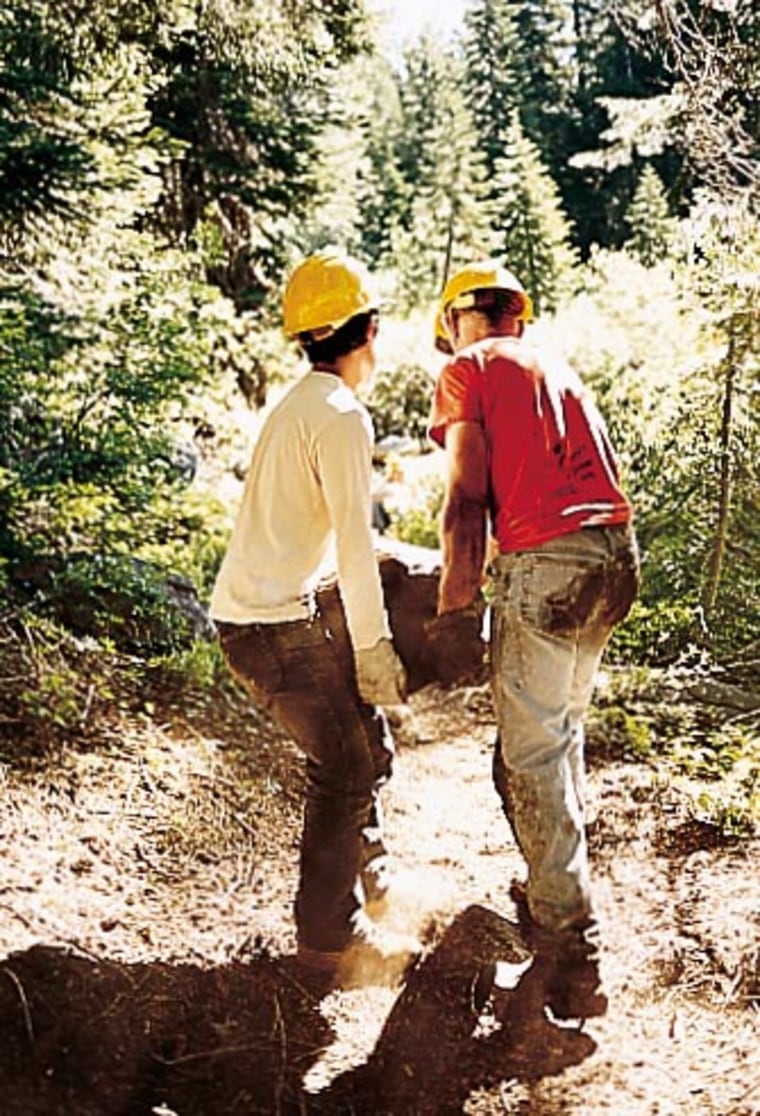The Volunteer Vacations run by the American Hiking Society involve backpacking into the wilderness, then spending a week camping and working with a group of people you just met. Is this a recipe for a train wreck?
Before: The plan is to “log out a trail,” says Phil Pierard, 56, the ranger in charge of the trip, held June 20 to 27 in Six Rivers National Forest, near Orleans, Calif. There will be “tread work”—repairing ground damaged by water erosion—and volunteers may get to use a crosscut saw to cut sections out of trees that have fallen across the path.
Cancellations mean the trip has only four volunteers, plus Forest Service staffers. Everyone is excited about meeting people and doing satisfying labor in the outdoors. Most are experienced backpackers or have been on work trips. All are single. (Several A.H.S. trips have produced marriages—this is a reality show waiting to happen.)

One volunteer, Paul Snyder, a 52-year-old civil engineer from Berkeley, Calif., has been on 13 previous A.H.S. trips. He says he’s “not that gregarious” and considers the trips a “major social outlet.” As he points out, “The kind of people who are willing to pay to work are usually really easy to get along with.” Paul met his current boss on one trip: He’d coincidentally applied for a job at the guy’s company beforehand and got an interview—and offer— soon after the trip. “I worked hard and was a good leader,” says Paul, “and I think he was impressed that I did it all for free.”
For Ken Margiott, 44, a forester from Santa Rosa, Calif., the expectations lean toward doing quality trail work and seeing a new part of the state. It’s his third A.H.S. trip.
Carla Shafer, 49, who teaches freshman writing at Cornell, in Ithaca, N.Y., is the trip’s only female volunteer, and a first-timer. Her main goal is to make sure that her 15-year-old nephew, Josiah Shafer, has a good time. Since the trip will be Josiah’s first backpacking experience, Carla anticipates teaching him important skills like hanging a bear bag. In his own prep work for the trip, Josiah built a homemade camping stove, which he describes as “a little, tiny, mini stove that burns denatured alcohol.” He’s looking forward to getting a trail name—a nickname he’ll either be given by the group or come up with on his own. Both Shafers are vegetarians, and Carla mentions that she called Ranger Phil and found out that he was “not nearly as organized about his food plans” as she’d envisioned.
This is Phil’s first experience leading an A.H.S. trip. Carla’s call appears to have generated some insecurity about preparedness. “I’m not sure if we’re supposed to feed them. If we are—what?” he wonders. “Also, we’ve only got a short time to get acquainted and pick up supplies, and soon we’ll be 7.5 miles out in the woods.” A final concern is the delegating of work tasks: “Everybody wants to use the crosscut saw. It’s romantic.”
After: By all accounts, things turned out great. “Phil was a fantastic leader,” says Carla, who at the end of the week suggested the group go on a reunion trip next year.
“There wasn’t a clunker in the bunch,” says Phil. “No crybabies. We basically became friends—or at least pals.” (Phil brought three Forest Service volunteers to help: Cory Woodman, Julia Valenti, and Hiro Akiyama, a Japanese exchange student who spoke halting English and had a habit of forgetting tools.) Instead of romantic crosscut sawing, most of their efforts went toward countering erosion—everything from cutting back brush to moving 1,000-pound rocks. No power tools are allowed in wilderness areas, so the group used shovels, axes, picks, and Pulaskis (half ax, half grub hoe). Everyone found it satisfying to know their work would keep the trail serviceable for a decade. “I lead a fairly sedentary life,” says Carla. “I wanted to get tired and dirty. I sure did. My arms are scratched up, and I have bruises all over my legs. It felt good in a strange kind of way.”
“We worked like dogs all week,” says Paul, happily.
Phil made sure that the group had plenty of time to relax. After toiling in the morning, everyone was free to head back to camp, go for a walk, read a book, or take a bath using the water bucket. A more appealing option was to go for a swim in Monument Lake, where there is also good fishing. Since Phil is an avid fisherman, he gave Josiah pointers and helped him catch and clean two six-inch trout. They cooked the fish at the camp, and even though Josiah is a vegetarian, he found the fish to be “pretty good.” (Alas, his stove didn’t work.) The other food ranged from homemade (by Phil) clam chowder and London broil during the first two days to A.H.S.-provided freeze-dried lasagna—“so-called lasagna” in Paul’s words—later in the week. Mealtimes were when everyone really got to know each other. “These things have the potential to get monotonous,” says Ken. “But with a good group, when everyone works together and is interesting, it works. This was the best trip I’ve been on.”
Josiah, by the way, got a trail name from his aunt: Walking Stick. He says he’d prefer something like Knotty Alder, but for now Walking Stick will have to do. “Because he’s such a stripling,” says Carla.
The American Hiking Society runs more than 100 trips each year, all across the country, graded from easy to very strenuous (this one was moderate to difficult). Normal group sizes are 8 to 10; 60 percent of volunteers are return customers. The registration fee is $100. You have to pay your way to the area (transportation is tax-deductible), but the host will usually arrange a pickup at the airport. You must bring your own camping equipment, though food tends to be included. 800/972-8608, ext. 206, americanhiking.org.
Previous:
